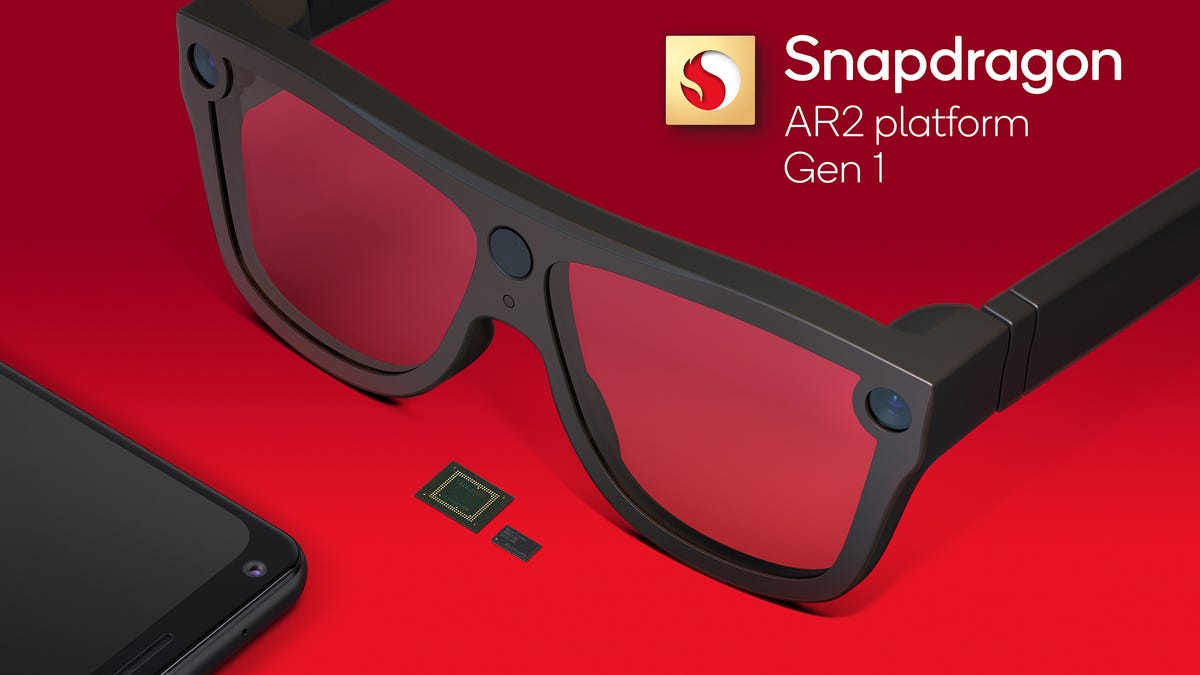 Why You Can Trust CNET
Why You Can Trust CNET Qualcomm's New AR Chips Point to a New Generation of Smart Glasses
The less power-hungry chips support Wi-Fi 7 and eye tracking. They're expected to arrive in glasses between 2023 and 2025.

The AR2 Gen 1 looks to power compact AR glasses coming in the next few years.
Amid a recent uptick in VR headsets, Qualcomm's latest chip announcement hints that the next product wave could be AR glasses. At the company's recent chip-focused event, the newest Snapdragon phone processors were announced, along with a brand-new line of AR glasses-optimized chips that point to a next wave of advanced smartglasses expected to arrive between 2023 and 2025, with possible features including eye tracking, hand tracking and wireless streaming to phones or from the cloud.
The Snapdragon AR2 Gen 1 is a different type of platform than the company's top-end XR2 processor, which is already in standalone VR headsets like the Meta Quest 2 and Pico 4. The AR2 focuses more on camera and sensor-based processing than on graphics, aiming to improve battery life on smaller glasses. The design is split into three co-processors, which are meant to live in each arm of a pair of smartglasses and also above the bridge. It's meant to cut down on wires and reduce overheating on future glasses designs.
Glasses using the AR2 Gen 1 may be a lot faster at using cameras for scanning and depth sensing: Qualcomm is promising faster AI for things like object recognition and hand tracking than even the XR2 chip found on headsets such as the Quest 2, but using half as much power as the XR2 chip. There's nowhere to hide a big battery on a normal-ish pair of glasses, which is why the AR2 Gen 1 aims to be efficient in ways that are reminiscent of the needs of wearables like smartwatches.
The AR2 Gen 1 chips are designed to spread across AR glasses, living in each arm and on the bridge to reduce bulk and heat.
The AR2 Gen 1 chip won't be used for traditional VR headsets. According to Qualcomm, the resolution and field of view in AR glasses using these new chips won't be as good as what current VR is capable of. Existing AR glasses and headsets tend to have smaller viewing areas and rely on occasional pop-up graphics, versus the expansive full-field graphics and displays VR needs.
Qualcomm is leaning heavily on phones, computers and the cloud to do a lot of the heavy lifting for these future glasses. The chipset includes Wi-Fi 7, and a range of phones running Qualcomm's Snapdragon chips and the Snapdragon Spaces software platform could be used to wirelessly process AR graphics for these glasses. Essentially they're wearable peripherals, although the glasses could do some things on their own, too.
Eye tracking on the glasses comes with support for iris authentication, which is handled on-glasses with a dedicated security chip. How that gets used by other manufacturers, however, remains to be seen.
Qualcomm's already announced a wave of familiar tech names that are onboard to make AR glasses with the AR2 chip, including Lenovo, LG, Niantic, NReal, Oppo, Pico, NTT Qonoq, Rokid, Sharp, TCL, Vuzix and Mi. Microsoft and Adobe are also working on making their software platforms cross-compatible, which mirrors recent partnership news with Meta earlier this year.
Partnerships are necessary, especially for devices like smart glasses that are trying to be useful tools in a world of already well-connected phones, computers, wearables and smart home gear. Microsoft has already announced a partnership with Qualcomm on future AR glasses chips earlier this year, and the AR2 Gen 1 looks like it'll be a part of that evolution beyond the expensive, business-focused HoloLens 2.
Qualcomm previously worked on chips for existing AR headsets and smart glasses, including the NReal Light, Lenovo's ThinkReality A3 and Meta's Ray-Ban Stories. However, Qualcomm's head of XR, Hugo Swart, indicated in a briefing with reporters that current efforts haven't been good enough at running long enough on a single battery charge to be useful. (Battery life on nearly all existing VR and AR headsets tends to be under 2 hours at best.)
Dreams of the metaverse are, for the moment, held back equally by hardware and software. While VR headsets are slowly adding AR-like features using passthrough cameras, like in the Meta Quest Pro, there aren't any all-day AR glasses that are actually any good, although some headsets like the Magic Leap 2 are trying to get closer to being useful for practical business uses. Perhaps Meta, which has been promising its own AR glasses for years, will lean on the AR2 Gen 1 as well for a future product.
There's nothing available yet that resembles the eyeglass tech sci-fi writers have been dreaming of for decades. Qualcomm's new chips may not lead to perfect AR glasses, but these chips may lead to improved, wireless glasses of the type that haven't existed previously. Maybe this wave of AR2 Gen 1-enabled glasses could be the start of the true AR eyewear we've been waiting for.

